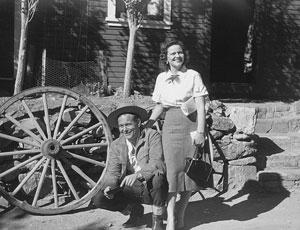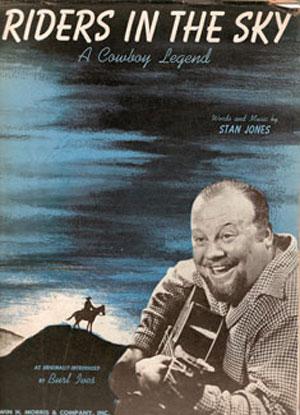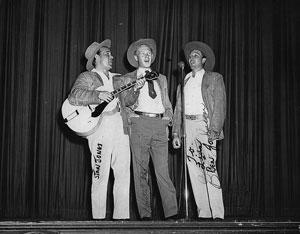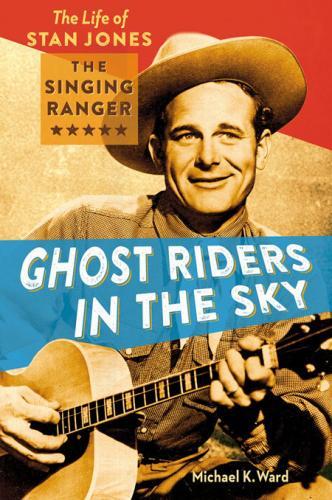Over the years park rangers have demonstrated some impressive talent, but when it comes to securing a place in entertainment history, few can compete with Stan Jones. He was working as a ranger in Death Valley National Monument in the late 1940s when a series of serendipitous events led to a remarkable new career, and his story is told in an entertaining new book, Ghost Riders In the Sky: The Life of Stan Jones, The Singing Ranger.
If you were to compile a list of the most-recorded songs in the American music industry, "Ghost Riders In the Sky" would certainly find a spot on your tally. The story behind the success of that song, and the remarkable career of the man who became known as the "singing ranger," is nicely told by Michael K. Ward in a book that will appeal to a variety of audiences.
Anyone who enjoys glimpses into the lives of park rangers in bygone eras, or a peek behind the scenes at the entertainment industry in the second half of the twentieth century, will find something to like in Michael Ward's book.
Arizona Desert Roots
Born in 1914, the future ranger grew up in Douglas, Arizona, and spent much of his free time as a child and youth roaming the surrounding desert and mountains. This book is a biography, and the first four chapters of the book provide the necessary background to set the stage for the rest of the story, including a look at the various stories about Stan Jones' inspiration later in life for his song about "ghost riders."
During his late teens and early 20s, Jones bounced around a variety of jobs and homes in the West, and a brief stint in the peacetime Navy in the mid-1930s proved invaluable in one respect: an honorable discharge that allowed him to apply for an NPS job ten years later.
He "Jumped At The Chance" For A Job With the NPS
When Jones heard about a ranger position which had come open in late 1944 at Mount Rainier National Park, Ward writes that "...Stan jumped at the chance. Here was an opportunity for him to land a job back in the woods, where he could utilize skills gleaned from his most memorable adventures as a youth..."
He landed the job, and anyone interested in a glimpse at life in the National Park Service during the late 1940s will enjoy Chapters 5 through 10 in Ward's book. They describe Jones' life as a ranger at Mount Rainier National Park and then at Death Valley National Monument; both the similarities and the contrasts with jobs in modern-day parks are striking.
Stan Jones and his wife Olive arrived at Mount Rainier in February 1945 and "soon became popular and active members of the local community." It seemed that Jones had finally found his calling.
According to Ward, "Stan Jones and the National Park Service constituted a nearly perfect match. Rangers of that era did it all, from mundane maintenance chores to dangerous rescues, relying on inner grit, horse sense, and dedication to duty as they confronted any task that might call their way. Stan's diverse mix of blue collar experience combined with his warm, open personality and love of the outdoors made him an ideal public servant."
A "Fascination With The Glory Days Of The Old West"
Stan may have been an ideal fit for his job, but his musical talents were developing as well. His wife Olive had encouraged Stan's creative skills and his "fascination with the glory days of the Old West," and had given him a Martin tenor guitar.
Jones was a natural storyteller, and he began use that instrument to transform his cowboy stories into cowboy songs. A friend later recalled Stan's passion for music, and notes that "he loved to strum his guitar and sing cowboy songs, requiring only the slightest or even no encouragement to drag out his guitar and perform."
The author's descriptions of NPS life at Mount Rainier during and immediately following World War II are both entertaining and enlightening. Stan's first year of "rangering" included a visit to the park by President Truman, a postwar flood of visitors, rescues on the mountain, problems with bears, crowds of winter sports enthusiasts at Paradise, snow removal on roads and rooftops, and'when other duties slowed'the crafting of an apparently endless stream of routed cedar signs for use throughout the park.
Back To His Desert Roots
In August 1945, after just over a year at Mount Rainier, Stan Jones opted for a transfer away from snow and the sign shop, and made a move to a much different world at Death Valley National Monument. He and his wife Olive were soon assigned to the Emigrant Ranger Station, and the personable couple soon "developed a network of friends, mainly miners and ranchers from areas adjacent to the monument."

Stan and Olive Jones at Wildrose Station, Death Valley National Monument. Photo courtesy of Myrtle Murchison and Rio Nuevo Publishers
Better still for Stan, the Stovepipe Wells Hotel was only nine miles away, and was soon providing a "welcome venue in which Stan could entertain visitors and locals with his song-writing talents." Even Jones' "day job" provided chances to share his music. The ranger's duties included presentation of programs about the park's natural history, and at the end of his talks, "he invariably picked up his guitar to treat the visitors to a few of his 'cowboy songs.'"
Most of his ranger tasks were more prosaic, and he "roamed the vast desert monument in his patrol pickup... ready to dig out vehicles stuck in the sand, cool overheated radiators, pursue lawbreakers, search for lost hikers, or simply be a friendly, knowledgeable contact to the visiting public."
"Hollywood Converged On Death Valley"
In 1947 Stan Jones sat down one day at the Emigrant Ranger Station and wrote "Ghost Riders in the Sky." His timing, in retrospect, was very good, because in May of 1948 Hollywood converged on Death Valley.
Three major motion picture companies set up shop in the park and leased facilities at both the Furnace Creek Ranch and Stovepipe Wells Hotel. The list of arrivals included some of Hollywood's biggest names of that era: director John Ford and actors John Wayne, Ward Bond and Harry Carey, Jr.
Ward's book offers some interesting perspective on the relationship between the NPS and major movie production companies over a half century ago. He notes that "The NPS regulatory grip wasn't quite as rigid back in the 1940's... Nonetheless, Superintendent Goodwin made sure that a park ranger was on board at all locations to 'check on any violations of Park Service rules.'''
At times those duties fell to Stan Jones, and Chapter 7 of Ward's book includes a hilarious tale of an incident involving director John Ford, John Wayne and a barrel cactus. In one scene in the movie, Wayne was trying, without success, to squeeze water from a chunk of pulp taken from the desert plant.
"You Can't Get Water Out Of That Kind Of Cactus!"
Ward sets up the story nicely: "Unaware of John Ford's disciplinary measures on his movie sets, Stan, in his typically relaxed and breezy manner, piped up, 'You can't get any water out of that kind of cactus!'"
"Ford, unaccustomed to being interrupted in the middle of shooting a scene, yelled "Cut!" and tensed like an angry pit bull. He slowly turned in his chair and barked, 'Who the hell said that?' Ranger Jones, unfazed, stepped forward. 'I did, Mr. Ford. That barrelhead cactus has some moisture in it but you'll never get it to drip into that canteen."
Ford, using the colorful language for which he was famous in the movie industry, demanded to know who Jones was, and what made him an authority on cactus. '"It's my job, sir,' replied Stan, resplendent in his Park Service uniform and flat hat. 'No water in that cactus."'
The rest of the exchange, as told by Ward in Chapter 7 of the book, makes a great tale. Neither Jones nor the famous director could know at the time that the encounter would set the stage for a future business relationship.
As soon as Ford's work in the park was completed, Stan Jones was assigned to keep an eye on a second movie being filmed at Death Valley. "At night," Ward relates, "Stan Jones morphed into a singing ranger...treating the cast and crew to his growing repertoire of original songs."
An Enthusiastic, Captive Audience
"...In the nine days that the ...company was ensconced at Stovepipe, Stan had an enthusiastic, captive audience to entertain. Chief among his many new fans was leading man Randolph Scott. It was Scott more than anyone else who was convinced that 'Ghost Riders in the Sky' could become a hit song, and it was ...his urging...that gave Stan the gumption he needed to head to Los Angeles and try to get his songs published."
Yet a third assignment to keep an eye on a movie company followed, and this one led the personable Jones and the actor Gregory Peck to "take a shine to each other on the set"; they would end up "as life-long friends."
After the departure of the movie companies, Stan resumed his routine ranger duties, but kept his resolve to have his songs published. In late August, he took two weeks of annual leave, and headed to Hollywood to try to sell some of his songs.
The eventual outcome would be what the author describes as "implausible" and "unimaginable," but at the end of his trip, Stan Jones returned to Death Valley to resume his ranger duties. He had "no reason to believe [his trip] would amount to much," but Michael Ward's account of the way "Ghost Riders in the Sky" found its way to the hands of recording artist Burl Ives and on to stardom deserves to be read in its entirety in the book.
So, how successful was "Ghost Riders in the Sky"?

The original published sheet music of "Riders in the Sky: A Cowboy Legend." Photo courtesy of Michael Ward.
The song's initial release in February 1949, sung by Burl Ives, attracted some attention, but a second version by Vaughn Monroe in March 1949 "took the American airways by storm." By April 15 it was on the Billboard charts of the top songs in the country, where it remained for 22 weeks, even reaching the coveted "number one" spot.
"Selling At A Record-Breaking Pace"
An article in Billboard on April 23, 1949, noted that Vaughn Monroe's song was "selling at a record-breaking pace..." and RCA Victor Records was "going all-out promotion wise, and will have a dirigible over the [New York] city Saturday, flashing the platter title and playing the record over a p.a. system..."
Ranger Stan Jones' "cowboy song" had traveled quite a distance from its birthplace on the porch of the Emigrant Ranger Station at Death Valley.
The stunning success of Ranger Jones and his song were mentioned in the Superintendent's report from Death Valley for April 1949, which noted that "Newsweek and Time wrote him up and Life sent photographers [to the park] for an illustrated article..."
Jones was quickly exhausting his annual leave to handle his music-related activities, and it was becoming clear he'd have to make a decision between his NPS job and the uncertainties of long-term success in Hollywood.
In an era when television was in its infancy and recorded music meant phonograph records played on a turntable, the ultimate test of a song's success was whether it merited a spot on a popular Saturday night radio program, "Your Hit Parade." The nationally broadcast show played the top ten songs of the week, and on May 21, 1949, Stan Jones' wildest dreams came true when Frank Sinatra introduced the number one song in the country, and "tore into Stan's song like it was his very own."
Aided by that validation, Stan Jones decided to take his chances with the entertainment business, and he resigned from the NPS on June 21, 1949. The gamble paid off. On July 7, RCA announced that Vaughn Monroe's recording of "Ghost Riders in the Sky" had sold an unprecedented 1,800,000 copies'in just the previous two months.

Stan, Dobe Carey and Ben Johnson on a promotional tour for John Ford's movie Wagon Master. Courtesy of Douglas B. Green and Rio Nuevo Publishers.
Stan Jones went on to a successful career which included work in radio, television, film and music with Walt Disney, John Ford and other Hollywood icons, and those years are nicely covered, with plenty of entertaining anecdotes, in the second half of the book. Jones never, however, lost his love for the national parks.
Still A Ranger At Heart
In the late 1950s,"still pining for the days when he wore 'the uniform, the badge and the insignia as a Ranger,' Stan temporarily hung up his cowboy garb and donned once again the famous 'flat hat' worn by National Park Service rangers. Building upon the core repertoire of songs he had written for his 'Ranger Chorus' concerts earlier in the decade, he developed a combined spoken and musical tribute to the Park Service''Songs of the National Parks.'"
The Walt Disney Music Company released the album in 1958, and the cover included images of the Grand Canyon and Old Faithful, the official arrowhead insignia of the NPS, a photo of a smiling Stan Jones in his full-dress Park Service Uniform, and a message from NPS Director Conrad Wirth. The agency was clearly happy to be associated with the "singing ranger."
Jones composed a letter touting the album to bookstore partners at parks around the country, and wrote, "I, personally, may or may not be known to you. I removed the uniform, the badge and the insignia as a Ranger some nine years ago this month. I have done many things and been many places, but I still find in my own heart that I really never have disassociated myself with the Service."
The singer continued his involvement in the entertainment industry into the early 1960s. He died of cancer in December 1963, at the age of 49.
Sixty-Plus Years And Still Going Strong
In the sixty-plus years since its initial publication, hundreds of versions of "Ghost Riders in the Sky" have been recorded by individual artists and groups representing almost every conceivable musical genre. You'll find YouTube versions of the song by everyone from Johnny Cash and Willie Nelson to the Boston Pops, from Elvis to the Norman Luboff Choir, and The Brothers Four to Lawrence Welk.
Michael Ward notes the seemingly timeless appeal of a song that knows no geographical limits in his book's final chapter:
"The 2007 film, Ghost Rider, based on a Marvel Comics character, features a great rock-and-roll version of 'Ghost Riders in the Sky' performed by the Australian alt-rock band, Spiderbait. As of this writing there are more seven million hits on the YouTube videos that combine scenes from the film and Spiderbait's recording of 'Ghost Riders.'"
"'Ghost Riders in the Sky' remains deeply infused throughout myriad American musical traditions," Ward concludes. "Barring a cataclysmic collapse of western civilization, it's here to stay."
The book is available from Amazon.com and other booksellers.
Like to hear the original Vaughn Monroe recording that made this song a nationwide sensation in 1949? Click on the link below to hear it via YouTube.




Comments
dDoes the book menti the Gene Autry movie "Ghost Riders in the Sky?" Gene performers the song which has a lot to do with the movie.
Fantastic!